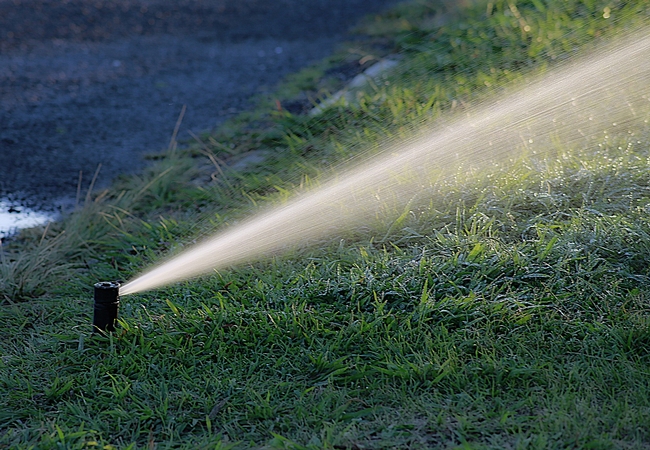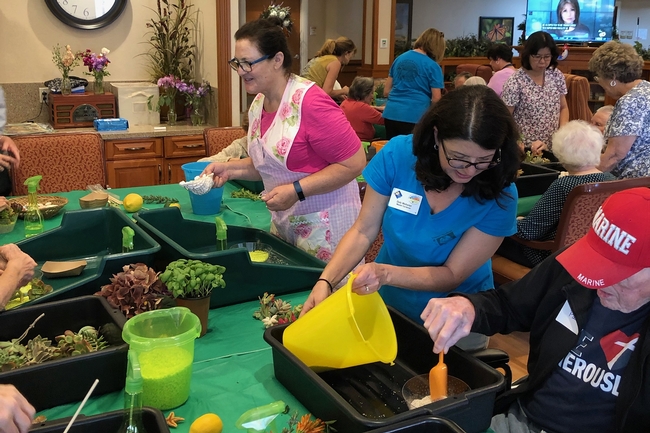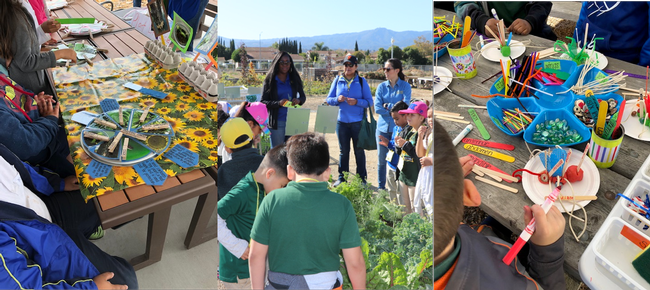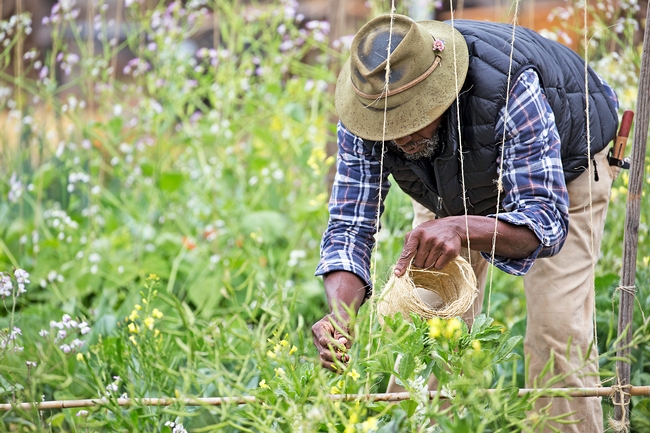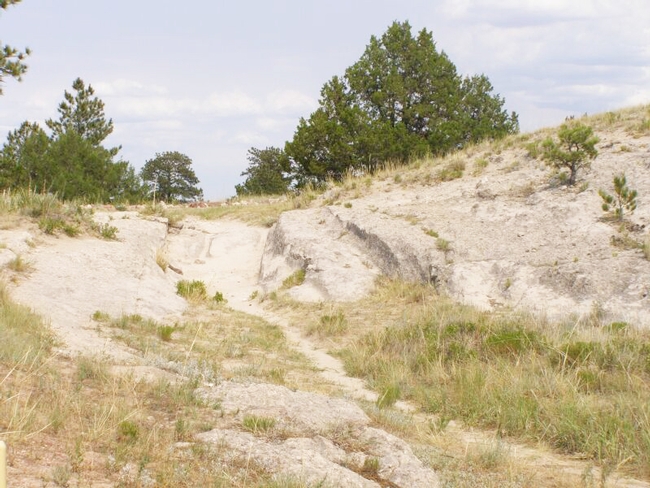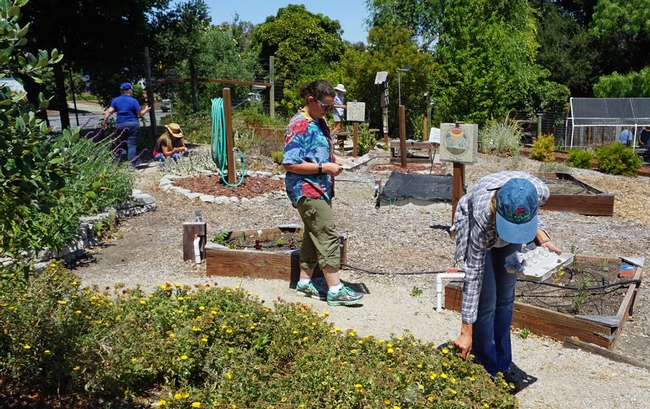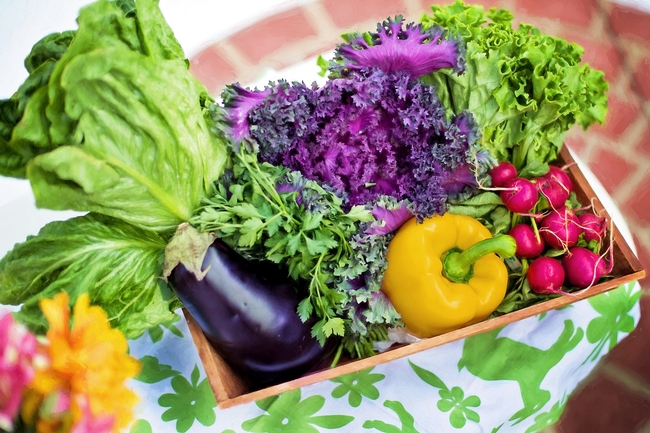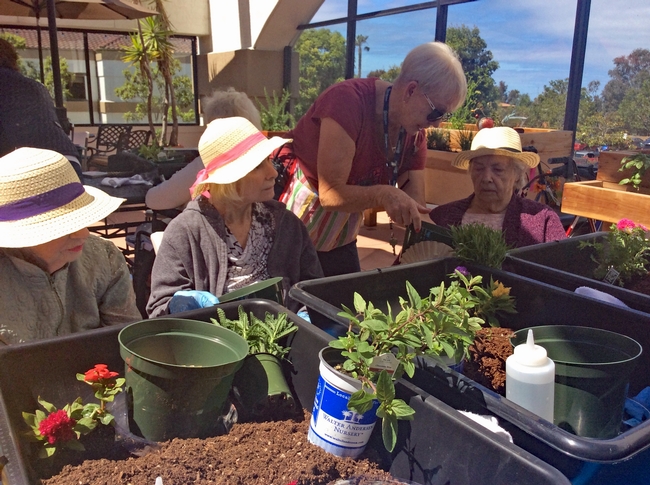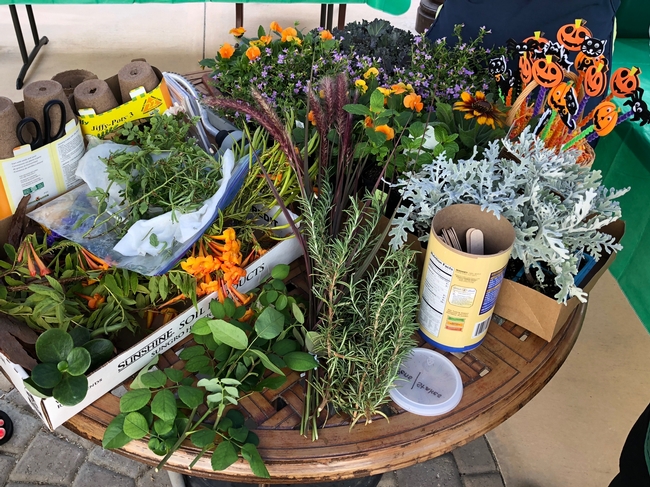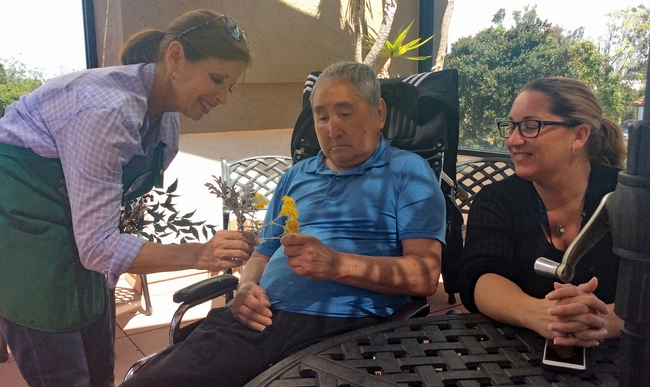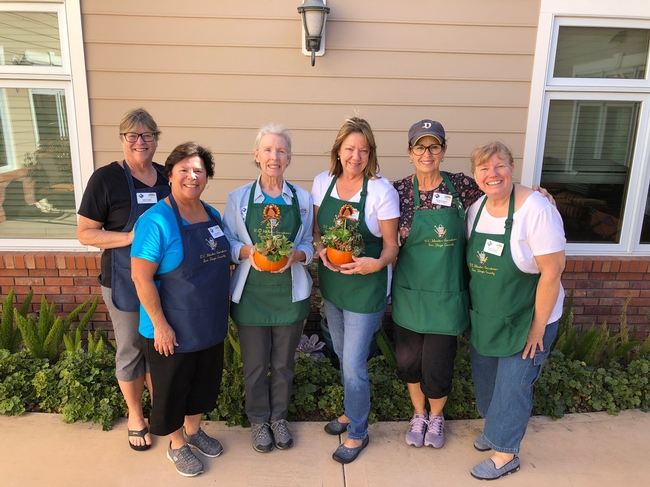Posts Tagged: Master Gardener Program
UC Master Gardeners ‘Garden Walks’ conserves millions of gallons of water annually in Marin
The Marin Municipal Water District has saved nearly 30 million gallons of water since it initiated a partnership with UC Cooperative Extension's Master Gardener program in Marin to teach residents how to conserve water.
The program, Garden Walks, was established in 2008 to help Marin conserve water in a district with limited supply. MMWD purchases about 75% of its water from reservoirs on Mt. Tamalpais and in west Marin, and the rest from Sonoma County's Russian River water system.
Garden Walks provides personalized information and advice to water district customers focused on improving their irrigation practices to conserve water. The part-time coordinator sets up about 150 appointments a year for UC Master Gardener volunteers to visit the homes of Marin County residents and teach them how to manage their outdoor water usage with conservation in mind.
“When we finish our visits, I hope that the client is more confident about being proactive in their garden,” said Pam Polite Fisco, the program coordinator. “We hope they will be saving water, will use natives and will encourage wildlife in their gardens.”
The volunteers, dispatched in pairs, spend about an hour at the homes. They walk the garden and talk with residents about grouping plants with similar water requirements, adding mulch to the soil surface and composting clippings, leaves and other green waste so it stays on the property.
The UC Master Gardeners teach the residents how to check their water meters and use the meter to help determine whether there are leaks in the system. They provide advice on water-conserving plants, such as natives or other drought-tolerant plants. They ask the residents to run their sprinklers and other irrigation systems to ensure they know how to manage the controls.
The majority of the water savings realized by the program stems from repairing leaks and cutting back on overwatering, said Steven Swain, UC Cooperative Extension horticulture advisor and the technical advisor to the Marin County Master Gardener program.
As part of their agreement with UC Cooperative Extension, the Marin Water District monitors changes in water usage and reports them annually on their website, allowing Swain to determine the program's impact.
The majority of water savings during the life of the program is attributable to just one quarter of the houses Master Gardeners visited; three quarters of participants were managing water sustainably.
“Sometimes, our volunteers just give the residents a pat on the back and compliment them for a job well done,” Swain said.
About 6% of the clients visited have hidden water leaks in their irrigation systems. These leaks can waste huge amounts of water if not caught, and account for a large portion of the water savings. Another 18% of clients are overwatering, which accounts for much of the rest of the savings.
Considering the value of the water conserved by the Garden Walks program, the $40,000 annual cost to hire the coordinator is more than offset by the reducing amount of water the district must provide.
This program has received a number of awards, including the Marin Conservation League's Ted Wellman Water Award in 2010. In 2011, it received first place in the UC Master Gardener's Search For Excellence awards and the Community Outreach Award at the National Extension Master Gardener Coordinating Conference. Marin County residents have also praised the program.
“The Master Gardener team was friendly, professional and helpful and shared their positive attitude to their garden and their outreach,” said Fairfax resident ‘Julie' in a follow-up survey
‘Jean' of San Rafael said, “I'm a beginning gardener. They helped me figure out how to start off right.”
A number of California counties were inspired by the success of the Marin County Garden Walks program and have adopted similar efforts to visit homeowners and assess irrigation efficiency.
View a video about the Marin Garden Walks porgram:
To reach vets, kids, older adults, UC Master Gardeners partner with community organizations
Successfully supporting farming, homemaking and youth development with science-based solutions during UC Cooperative Extension's first 60 years in California prompted UC Agriculture and Natural Resources leaders to consider other ways the same concept could improve American lives.
One of those was the development of the UC Master Gardener Program in 1980, which recognized the need for science to inform sustainable and safe home food production for healthy diets, physical activity, education and mental well-being.
Over the years, the program has trained tens of thousands of UC Master Gardener volunteers to support residents of more than 52 California counties with environmentally sound ways to manage garden pests, reduce water use and grow fruits and vegetables. Today, there are more than 6,000 active UC Master Gardener volunteers.
Each of the 52 counties within the UC Master Gardener Program has unique projects that support its community needs, from reducing water use in home landscapes, diverting green waste from landfills and creating pollinator habitats to support pollinator populations. All counties answer gardening questions for free using a telephone hotline or email inquiry system. Master Gardener volunteers in many counties support community, school and demonstration gardens to share knowledge and spark inspiration. All focus their efforts on education.
To make still greater gains in outreach efforts, the UC Master Gardener Program enlists community partners that share its values. For example, the UC Master Gardener Program in Contra Costa County works with the County Department of Behavioral Health, Bi-Bett Corporation, Eden Housing and the Veteran's Affairs campus to provide gardening lessons to older adults, behavioral health patients and veterans.
“Gardens bring people together, regardless of race, color, age, sex, disability or religion,” said Missy Gable, statewide director of the UC Master Gardener Program. “Our volunteers in Contra Costa County carefully identified key gardening topics and the best delivery options for a variety of learning styles.”
The lessons covered vegetable gardening, soil health, composting, supporting pollinators and garden pest management.
UC Master Gardener volunteers in San Diego County worked with residential memory care communities and Alzheimer's San Diego to offer sensory gardening activities to people with dementia. The ‘Reminiscence Gardening' project in San Diego County was funded with a community grant and donations.
“Participants explored herbs, fruits and vegetables to activate the senses of sight, touch and smell,” Gable said. “In doing so, they worked their brains and their bodies, connecting their senses with memories, all the while also working on fine motor skills and muscle tone.”
In Santa Clara County, UC Master Gardener volunteers developed science- and nutrition-based field trip activities to present at their demonstration garden and, with local grants, help pay to transport children from low-income neighborhoods to the garden for a day of hands-on learning.
Children learned about the plant life cycle and planted sunflower seeds to take home and watch grow. They tasted vegetables and discovered the benefits of eating fresh produce of many colors. After learning how to collect insects and identify them, UC Master Gardener volunteers invited them to release beneficial insects at the park.
“UC Master Gardener volunteers encouraged the children to return to the garden with their families to share their experiences,” Gable said. “Children are often an important driver of both food and recreation choices for families so encouraging them to continue their gardening journey is key to seeing change at the family level.”
During the COVID-19 crisis, when many families and children had to stay at home for their protection, interest in home gardening surged. UC Master Gardener volunteers and coordinators sought out safe ways to reach new gardeners with research-based information.
In Calaveras County, UC Master Gardener volunteers provided gardening kits for school children distance-learning at home. UC Master Gardeners in San Bernardino County offered monthly gardening sessions via Zoom to their community. UC Master Gardeners in Contra Costa and Alameda counties donated vegetable transplants to students and families in the Oakland Unified School District. In Santa Barbara County, volunteers taught local residents how to grow an abundance of high-demand fruits and vegetables for food banks.
“Our volunteers didn't skip a beat,” Gable said. “They live and work in the communities we serve, so they can identify where needs are and connect with like-minded partners to provide the widest possible distribution of trusted gardening information.”
The UC Master Gardener Program and other UC ANR statewide programs rely on donor contributions. To learn more about how to support or get involved with the UC Master Gardener Program in your community, visit mg.ucanr.edu.
Home gardening is more pleasant and successful with healthy soil
With winter soon upon us, it's a good time to treat your garden bed just like the one where you tuck in at night, says Dustin Blakey, UC Cooperative Extension advisor, director and UC Master Gardener coordinator in Inyo and Mono counties.
Blakey hosted a webinar on Facebook during Healthy Soils Week 2020 (Nov. 30 – Dec. 5) to advise home gardeners how to promote healthy soils to maximize their gardening success.
“Some genius suggested we call garden plots ‘beds,'” he said. “It makes sense. Mom was right. Don't stand or walk on the bed. Keep it neat and tidy. And cover it, in the case of a garden bed, with organic mulch.”
The goal is to end up with garden soil that holds adequate water, nutrients and air, supports soil life forms, like worms, insects and microorganisms, and is convenient to work with.
“If I have to get a mallet to bang a trowel into the ground, it's not healthy soil,” Blakey said.
As a first step, designate permanent walkways in the garden so only those areas become compacted by foot traffic, leaving the plots where vegetables will be grown undisturbed.
“Along parts of the Oregon Trail, almost 200 years later you can still see the ruts where the wagon wheels rolled, and plants aren't growing there,” Blakey said.
He recommended gardeners cover their walkways with gravel, decomposed granite or organic materials like wood chips, bark or grass. Installing raised garden beds is an ideal way to differentiate growing and walking areas. In his own garden, Blakey built the beds four feet wide to have easy access to all the plants while standing on the walkways.
Add compost to the soil inside the beds to reap a variety of benefits.
“It's often said, no matter the problem, compost is the solution,” Blakey said.
Compost provides a food source for beneficial microorganisms in the soil. If soil is sandy, compost helps it hold water and nutrients. If the soil is clay-like, compost loosens the soil, making it more friable.
Covering the garden soil surface with mulch or cover crops is also critical to soil health, Blakey said. The topping moderates the soil temperature, supporting the organisms living below ground. The covering helps prevent weeds, and as the mulch breaks down, it adds organic matter to the soil.
“You can also grow cover crops,” Blakey said. “I'm surprised how few gardeners use cover crops. Put some seeds in the ground instead of buying a bag of amendments.”
Cover crops can be part of a healthy garden crop rotation, keeping roots growing in the soil all year long.
“Grasses scavenge nutrients. Legumes fix nitrogen. I grow sweet potatoes. They shade everything and keep the weeds at bay. A daikon radish cover crop penetrates deep into the ground, naturally tilling the soil,” he said.
Blakey discourages a common habit of some long-time gardeners, frequent rototilling with a heavy machine, and rather encourages what he calls “gentle tilling.”
“You don't need power equipment. Experiment with using a shovel,” he said. “My soil is loose and easy to work. Some beds, I don't even turn. I just plant directly in the healthy soil.”
View a recording of Blakey's one-hour webinar on healthy soil on the UC Master Gardener Program Facebook page: https://www.facebook.com/UCMasterGardeners. The UC Master Gardeners offer many online gardening resources and programs in most California counties. Find your local program at http://mg.ucanr.edu/FindUs.
Grow it: Gardening tips and resources
Gardening is fun…and it's an important activity. What we grow in school, home and community gardens can improve our health, and the health of our families and communities. What we grow can increase the resiliency of food systems in our communities. And what we grow, ultimately, can connect us more closely with the earth that sustains us. There are valuable lessons in gardening…too many to list here.
Even if you live in a small apartment, you can grow food. If you have a yard, you can grow quite a lot of food. View the transformation of a front yard in an urban area…from lawn to lush, productive food garden in only 60 days. You'll love the progression photos, and the simple explanation about how the garden came together.
Need more inspiration? Roger Doiron, founder of SeedMoney, talks about his (subversive) garden plot in this remarkable TedX talk. Roger created and led the social media campaign that called for a garden at the White House. This campaign ultimately led First Lady Michelle Obama to plant a vegetable garden at the White House. (And it may have also inspired the People's Garden at the USDA, which broke ground on Abraham Lincoln's birthday 10 years ago. Lincoln referred to the USDA as the “People's Department,” so it makes sense that the USDA would refer to its garden as the “People's Garden.”)
Need practical advice? The UC Master Gardener program has more than 5,000 certified volunteers ready to assist if you live in California. UC has also created a California Garden Web portal that provides a treasure trove of gardening resources for all parts of the state. It's not too early to begin planning your Fall garden, and you'll find information about that, too.
If you're interested in school gardens, read this brief history, written by UC ANR's UC Food Observer.
Happy gardening!
UC Master Gardeners partner with Alzheimer's San Diego in Reminiscence Gardening project
The UC Master Gardener Program of San Diego County has always been open to innovative ways of expanding its mission and passion for gardening into new parts of its community. The San Diego program has a rich history of successful partnering with other local organizations to reach under-served populations. An exciting new collaboration was unveiled in March 2018 when five UC Master Gardener volunteers took their newest public outreach project Reminiscence Gardening to the Alzheimer's San Diego's (AlzSD) social activities program.
Thirty participants, all community members being served by AlzSD, got their hands dirty and enjoyed a day of sensory stimulation through tabletop gardening activities planned by the UC Master Gardener leaders. The 90-minute program gave participants the opportunity to touch, move, smell, hear and see the joys of manipulating soil and plants to construct a simple potted creation to adorn their spring celebration table.
UC Master Gardener volunteers knew it would be important to develop activities that were fun and, hopefully, something those in attendance had previously enjoyed. With marigolds, chrysanthemums and mint varieties in hand, participants and caregivers, worked side-by-side and guided by UC Master Gardeners, dug into the bins filled with soil, pots and tools. Each set of participants was given three plants to pot up. As this first activity progressed, UC Master Gardeners could see that participants were being drawn out and interactions around the worktable were increasing. The physical, intellectual, emotional and social benefits of gardening were being experienced and shared by all.
Other sensory-heavy opportunities, all planned and guided by UC Master Gardeners, were included in the program. Participants were asked to reach into a bin filled with loose soil and wriggler worms to re-familiarize themselves with that most basic part of backyard gardening – working the soil. A variety of plants in one-gallon containers were passed around. Each container was specially marked with an icon that invited the participants to experience the visual beauty, familiar smell, unique feel and, sometimes, sound and subtle taste of each plant.
Of particular interest was an activity in which everyone was asked to explore a box filled with hand tools, seed packets and other items typically used in backyard gardening. Clearly, old memories were refreshed. A vintage hose nozzle drew the attention of one gentleman. He held it for a while then began making the motions used in hand-watering the yard, moving the nozzle back and forth while mimicking the sound of water rushing forth from the attachment onto a once green and promising flower bed. Tangible signs of success, such as these, were everywhere during the social activity.
Jessica Empeño, MSW, Alzheimer's San Diego's Vice President of Programs and Services was in attendance and praised the work of the UC Master Gardener volunteers.
“Gardening was such a treat for our families. This activity stimulated all the senses – from the gorgeous colors of the flowers, the smell and taste of the herbs and the chatter and laughter that filled the room. Most importantly, those living with dementia and their care partners were able to socialize and have fun in a safe, judgment-free setting. We are so grateful to the UC Master Gardener Program for donating their time and supplies. We hope to have them back soon!”
The UC Master Gardener Program of San Diego was inspired by its growing understanding of the need for more everyday experiences to address the issues facing members of our community being affected by dementia-related diseases. Those numbers are increasing at a staggering rate. The National Alzheimer's Association estimates that currently 5.7 million Americans have been diagnosed with Alzheimer's, with nearly two-thirds of those being women, and that number will almost triple by mid-century. In San Diego County, AlzSD offers social activities for individuals with dementia and their caregivers. The “Reminiscence Gardening” project's goal for those individuals is to boost energy levels, build confidence, prolong maintenance of existing skills and perpetuate a sense of purpose and joy through gardening.
Further collaborations between the UC Master Gardener Program of San Diego County and other memory care communities are in the works. UC Master Gardeners want to share their love of gardening and their advanced training from the university for the benefit of those in our community who need it the most. Many of us know first-hand the responsibility of caring for a family member with a dementia-related disease. We know, too, the joys and benefits of being outdoors and sharing time together with people we love. We want to make a meaningful difference in our community and the Reminiscence Gardening project is a wonderful way to express that.
For a calendar of future events and more information about other programs offered by the UC Master Gardener Program of San Diego and Alzheimer's San Diego, please visit:
www.mastergardenersd.org
www.alzsd.org
